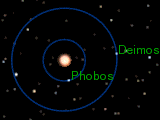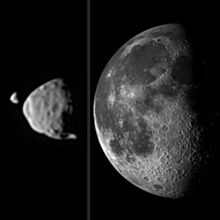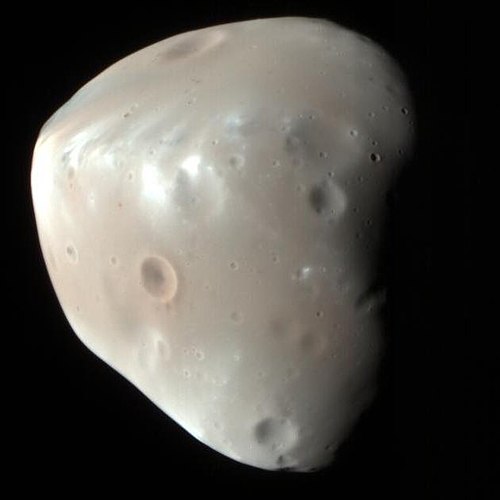Deimos (moon)
 Deimos, captured by theMars Reconnaissance Orbiterin false color | |
| Discovery | |
|---|---|
| Discovered by | Asaph Hall |
| Discovery date | 12 August 1877 |
| Designations | |
Designation | Mars II |
| Pronunciation | /ˈdaɪməs/[1]to/ˈdiːməs/[2]or as Greek Δεῖμος (approximated/ˈdeɪmɒs/)[3] |
Named after | Δεῖμος |
| Adjectives | Deimian/ˈdaɪmiən/[4] |
| Orbital characteristics | |
| Epoch23 September 2012 (JD2456191.5) | |
| Periapsis | 23455.5 km |
| Apoapsis | 23470.9 km |
| 23463.2 km[5](6.92 Mars radii) | |
| Eccentricity | 0.00033[5] |
| 1.263d[5] (30.312h) | |
Averageorbital speed | 1.3513 km/s[6] |
| Inclination | 0.93° (to Mars's equator) 1.791° (to the localLaplace plane)[5] 27.58° (to theecliptic) |
| Satellite of | Mars |
| Physical characteristics | |
| Dimensions | 16.08 × 11.78 × 10.22km (±0.16 × 0.12 × 0.10km)[7] |
| 6.27±0.07 km[7] | |
| 522±8 km2[7] | |
| Volume | 1033±19 km3[7] |
| Mass | 1.51×1015kg[8] |
Meandensity | 1.465±0.051 g/cm3[7] |
| 0.003 m/s2[6] (306μg) | |
| 5.556m/s (20 km/h)[6] | |
| Synchronous[5] | |
| Albedo | 0.068±0.007[9] |
| Temperature | ≈ 233K |
| 12.89[10] | |
Deimos/ˈdaɪməs/(systematic designation:Mars II)[11]is the smaller and outer of the twonatural satellites of Mars,the other beingPhobos.Deimos has amean radiusof 6.2 km (3.9 mi) and takes 30.3 hours to orbitMars.[5]Deimos is 23,460 km (14,580 mi) from Mars, much farther than Mars's other moon, Phobos.[12]It is named afterDeimos,theAncient Greekgod andpersonificationof dread and terror.
Discovery and Etymology[edit]

Deimos was discovered byAsaph Hallat theUnited States Naval ObservatoryinWashington, D.C.,on 12 August 1877, at about 07:48UTC.[a]Hall, who also discoveredPhobosshortly afterwards, had been specifically searching for Martian moons at the time.
The moon is named afterDeimos,a figure representingdreadinGreek mythology.[11]The name was suggested by academicHenry Madan,who drew from Book XV of theIliad,whereAres(Greek counterpart of the Roman godMars) summons Dread (Deimos) and Fear (Phobos).[18]
Origin[edit]
The origin of Mars's moons is unknown and the hypotheses are controversial.[19]The main hypotheses are that they formed either bycaptureor byaccretion.
Because of the postulated similarity to the composition ofC- or D-typeasteroids, one hypothesis is that the moons may be objects captured into Martian orbit from theasteroid belt,with orbits that have been circularized either by atmospheric drag ortidal forces,[20]as capture requires dissipation of energy. The currentMartian atmosphereis too thin to capture a Phobos-sized object by atmospheric braking.[19]Geoffrey Landishas pointed out that the capture could have occurred if the original body was abinary asteroidthat separated due to tidal forces.[21]The main alternative hypothesis is that the moons accreted in the present position. Another hypothesis is that Mars was once surrounded by many Phobos- and Deimos-sized bodies, perhaps ejected into orbit around it by a collision with aplanetesimal.[22][23]
In 2021, Amirhossein Bagheri (ETH Zurich), Amir Khan (ETH Zurich),Michael Efroimsky(US Naval Observatory) and their colleagues proposed a new hypothesis on the origin of the moons. By analyzing the seismic and orbital data from theMars InSight Missionand other missions, they proposed that the moons were born from the disruption of a common parent body around 1 to 2.7 billion years ago. The common progenitor of Phobos and Deimos was most probably hit by another object and shattered to form Phobos and Deimos.[24]
Physical characteristics[edit]

Deimos is a gray colored body. Like most bodies of its size, Deimos is highly non-spherical with triaxial dimensions of 16.1 km × 11.8 km × 10.2 km (10.0 mi × 7.3 mi × 6.3 mi), corresponding to a mean diameter of 12.5 km (7.8 mi) which makes it about 57% the size of Phobos.[7]Deimos is composed of rock rich in carbonaceous material, much like C-typeasteroidsandcarbonaceous chondritemeteorites.[25]It iscratered,but the surface is noticeably smoother than that of Phobos, caused by the partial filling of craters withregolith.[citation needed]The regolith is highlyporousand has a radar-estimated density of only1.471 g/cm3.[26]
Escape velocityfrom Deimos is 5.6 m/s.[6]This velocity could theoretically be achieved by a human performing a vertical jump.[27][28]Theapparent magnitudeof Deimos is 12.45.[9]
Named geological features[edit]
Only two geological features on Deimos have been given names. ThecratersSwiftandVoltaireare named after writers who speculated on the existence of two Martian moons before Phobos and Deimos were discovered.[29]
| Craters | Coordinates | Diameter (km) |
Approval Year |
Eponym | Ref |
|---|---|---|---|---|---|
| Swift | 12°30′N1°48′E/ 12.5°N 1.8°E | 1 | 1973 | Jonathan Swift;Irish writer (1667–1745) | WGPSN |
| Voltaire | 22°00′N3°30′W/ 22°N 3.5°W | 1.9 | 1973 | Voltaire;French writer (1694–1778) | WGPSN |
Orbital characteristics[edit]

Deimos'sorbitis nearly circular and is close to Mars'sequatorial plane.Deimos is possibly an asteroid that was perturbed byJupiterinto anorbitthat allowed it to be captured by Mars, though this hypothesis is still controversial and disputed.[19]Both Deimos and Phobos have very circular orbits which lie almost exactly in Mars's equatorial plane, and hence a capture origin requires a mechanism for circularizing the initially highlyeccentric orbit,and adjusting its inclination into the equatorial plane, most likely by a combination ofatmospheric dragandtidal forces;[20]it is not clear that sufficient time was available for this to have occurred for Deimos.[19]

As seen from Mars, Deimos would have anangular diameterof no more than 2.5 minutes (sixty minutes make one degree), one twelfth of the width of theMoonas seen fromEarth,and would therefore appear almost star-like to the naked eye.[31]At its brightest ( "full moon" ) it would be about as bright asVenusis from Earth; at the first- or third-quarter phase it would be about as bright asVega.With a smalltelescope,a Martian observer could see Deimos's phases, which take 1.2648[32]days (Deimos'ssynodic period) to run their course.[31]
Unlike Phobos, which orbits so fast that it rises in the west and sets in the east, Deimos rises in the east and sets in the west, slower than Mars's rotation speed. The Sun-synodic orbital period of Deimos of about 30.4 hours exceeds the Martian solar day ( "sol") of about 24.7 hours by such a small amount that 2.48 days (2.41 sols) elapse between its rising and setting for an equatorial observer. From Deimos-rise to Deimos-rise (or setting to setting), 5.466 days (5.320 sols) elapse.[citation needed]
Because Deimos's orbit is relatively close to Mars and has only a very small inclination to Mars's equator, it cannot be seen from Martian latitudes greater than 82.7°.[citation needed]
Deimos's orbit is slowly getting larger, because it is far enough away from Mars and because oftidal acceleration.It is expected to eventually escape Mars's gravity.[33]
Solar transits[edit]

Deimos regularlypasses in front of the Sunas seen from Mars. It is too small to cause atotal eclipse,appearing only as a small black dot moving across the Sun. Its angular diameter is only about 2.5 times the angular diameter of Venus during atransit of Venusfrom Earth. On 4 March 2004 a transit of Deimos was photographed by Mars roverOpportunity,and on 13 March 2004 a transit was photographed by Mars roverSpirit.[citation needed]
March 5, 2024:NASA released images of transits of the moon Deimos, the moonPhobosand the planetMercuryas viewed by thePerseverancerover on the planet Mars.
Exploration[edit]

Overall, its exploration history is similar to thoseof Marsandof Phobos.[34]Deimos has been photographed close-up by several spacecraft whose primary mission has been to photograph Mars, including in March 2023 during a rare close encounter by theEmirates Mars Mission.[35]No landings on Deimos have been made.
In 1997 and 1998, the proposedAladdinmission was selected as a finalist in the NASADiscovery Program.The plan was to visit both Phobos and Deimos, and launch projectiles at the satellites. The probe would collect the ejecta as it performed a slow flyby (~1 km/s).[36]These samples would be returned to Earth for study three years later.[37][38]The principal investigator wasCarle M. PietersofBrown University.The total mission cost, including launch vehicle and operations was $247.7 million.[39]Ultimately, the mission chosen to fly wasMESSENGER,a probe to the planetMercury.[40]
In 2008, NASAGlenn Research Centerbegan studying a Phobos and Deimossample-return missionthat would use solar electric propulsion. The study gave rise to the "Hall" mission concept, aNew Frontiers-class mission currently under further study.[41]
Also, the sample-return mission calledGulliverhas been conceptualized and dedicated to Deimos,[42]in which 1 kilogram (2.2 pounds) of material from Deimos would be returned to Earth.[42]
Another concept of sample-return mission from Phobos and Deimos isOSIRIS-REx 2,which would use heritage from the firstOSIRIS-REx.[43]
In March 2014, a Discovery class mission was proposed to place an orbiter in Mars orbit by 2021 and study Phobos and Deimos. It is calledPhobos And Deimos & Mars Environment(PADME).[44][45]
Human exploration of Deimos could serve as a catalyst for the human exploration of Mars. Recently, it was proposed that the sands of Deimos or Phobos could serve as a valuable material foraerobrakingin the colonization of Mars.[46]SeePhobosfor more detail.
ISRO'sMars Orbiter Missioncaptured the first pictures of the far side on Deimos.
In April 2023, astronomers released close-up global images, for the first time, of Deimos that were taken by the MarsHope orbiter.[47][48]Observations reported by this mission contravene the captured asteroid hypothesis and indicatebasalticplanetary origin of Deimos.[49]
See also[edit]
- List of missions to the moons of Mars
- List of natural satellites
- Moons of Mars– Natural satellites orbiting Mars
- Phobos and Deimos in fiction– Depictions of the planet
- Transit of Deimos from Mars– Transit of a Moon of Mars
Notes[edit]
- ^Given in contemporary sources as "11 August 14:40"Washington Mean Time,using a pre-1925astronomical conventionof beginning a day at noon,[13]so 12 hours must be added to get the actual local mean time.[14][15][16][17]
References[edit]
- ^The Century Dictionary and Cyclopedia(1914)
- ^"Moons of Mars – the Center for Planetary Science".
- ^"Deimos".LexicoUK English Dictionary.Oxford University Press.Archived fromthe originalon 22 March 2020.
- ^Harry Shipman (2013)Humans in Space: 21st Century Frontiers,p. 317
- ^abcdef"HORIZONS Web-Interface".NASA. 21 September 2013.Retrieved4 December2013.
- ^abcd"Mars: Moons: Deimos".NASA Solar System Exploration. 30 September 2003. Archived fromthe originalon 12 October 2012.Retrieved2 December2013.
- ^abcdefgErnst, Carolyn M.; Daly, R. Terik; Gaskell, Robert W.; Barnouin, Olivier S.; Nair, Hari; Hyat, Benjamin A.; et al. (December 2023)."High-resolution shape models of Phobos and Deimos from stereophotoclinometry".Earth, Planets and Space.75(1): 103.Bibcode:2023EP&S...75..103E.doi:10.1186/s40623-023-01814-7.PMC10290967.PMID37378051.103.
- ^Jacobson (2010), as cited in Ernst et al. (2023).[7]
- ^ab"Planetary Satellite Physical Parameters".Jet Propulsion Laboratory(Solar System Dynamics). 13 July 2006.Retrieved29 January2008.
- ^"Mars' Moons".
- ^abBlunck, Jürgen (2009). "The Satellites of Mars; Discovering and Naming the Satellites".Solar System Moons: Discovery and Mythology.Springer.p. 5.ISBN978-3-540-68852-5.
- ^Staff (2016)."Deimos".SeaSky.org.Retrieved23 January2016.
- ^Campbell, W.W. (1918)."The Beginning of the Astronomical Day".Publications of the Astronomical Society of the Pacific.30(178): 358.Bibcode:1918PASP...30..358C.doi:10.1086/122784.
- ^Hall, A.;Observations of the Satellites of Mars,Astronomische Nachrichten, Vol. 91, No. 2161 (17 October 1877, signed 21 September 1877) pp. 11/12–13/14
- ^Morley, T. A.;A Catalogue of Ground-Based Astrometric Observations of the Martian Satellites, 1877–1982,Astronomy and Astrophysics Supplement Series, Vol. 77, No. 2 (February 1989), pp. 209–226 (Table II, p. 220: first observation of Deimos on 1877-08-12.32526)
- ^Notes: The Satellites of Mars,The Observatory, Vol. 1, No. 6 (20 September 1877), pp. 181–185
- ^The Discovery of the Satellites of Mars,Monthly Notices of the Royal Astronomical Society,Vol. 38, No. 4, (8 February 1878), pp. 205–209
- ^Hall, A.;Names of the Satellites of Mars,Astronomische Nachrichten, Vol. 92, No. 2187 (14 March 1878, signed 7 February 1878), p. 47/48
- ^abcdBurns, J. A., "Contradictory Clues as to the Origin of the Martian Moons," inMars,H. H. Kiefferet al.,eds., U. Arizona Press, Tucson, 1992
- ^Landis, G. A., "Origin of Martian Moons from Binary Asteroid Dissociation," American Association for the Advancement of Science Annual Meeting; Boston, MA, 2001;abstract.
- ^Craddock, R. A.; (1994);The Origin of Phobos and Deimos,Abstracts of the 25th Annual Lunar and Planetary Science Conference, held in Houston, TX, 14–18 March 1994, p. 293
- ^"Close Inspection for Phobos".
accumulated ejecta from asteroid impacts on the Martian surface
- ^Bagheri, Amirhossein; Khan, Amir; Efroimsky, Michael; Kruglyakov, Mikhail; Giardini, Domenico (22 February 2021)."Dynamical evidence for Phobos and Deimos as remnants of a disrupted common progenitor".Nature Astronomy.5(6): 539–543.Bibcode:2021NatAs...5..539B.doi:10.1038/s41550-021-01306-2.ISSN2397-3366.S2CID233924981.
- ^"Moons of Mars – Planetary Sciences, Inc".Retrieved10 June2022.
- ^Busch, M. W.; et al. (2007). "Arecibo Radar Observations of Phobos and Deimos".Icarus.186(2): 581–584.Bibcode:2007Icar..186..581B.doi:10.1016/j.icarus.2006.11.003.
- ^"Vertical Jump Lab"(PDF).Archived fromthe original(PDF)on 26 June 2022.Retrieved18 February2021.
- ^"Vertical Jump Velocity Estimation".Google Docs.
- ^"Gazetteer of Planetary Nomenclature".USGSAstrogeology Research Program.
- ^Lakdawalla, Emily (9 March 2009)."Mars Reconnaissance Orbiter eye candy: HiRISE images Deimos".Planetary Society.Retrieved19 August2013.
- ^abRichardson, R. S.(December 1943),"If You Were on Mars",Astronomical Society of the Pacific Leaflets,vol. 4, Leaflet No. 178, pp. 214–221
- ^The Editors of Encyclopaedia Britannica."Deimos".Encyclopedia Britannica.Retrieved23 February2019.
- ^"Deimos: Facts About the Smaller Martian Moon".Space.8 December 2017.
- ^Mars Phobos and Deimos Survey (M-PADS)–A Martian Moons Orbiter and Phobos Lander(Ball, Andrew J.; Price, Michael E.; Walker, Roger J.; Dando, Glyn C.; Wells, Nigel S; and Zarnecki, John C. (2009). Mars Phobos and Deimos Survey (M-PADS)–A Martian Moons Orbiter and Phobos Lander. Advances in Space Research, 43(1), pp. 120–127.)
- ^Crane, Leah."Amazing images of Mars's moon Deimos snapped by Emirates Mars Mission".New Scientist.Retrieved25 April2023.
- ^Barnouin-Jha, Olivier S. (1999). "Aladdin: sample return from the moons of Mars".1999 IEEE Aerospace Conference. Proceedings (Cat. No.99TH8403).Vol. 1. pp. 403–412 vol.1.doi:10.1109/AERO.1999.794346.ISBN978-0-7803-5425-8.S2CID129101577.
- ^Pieters, Carle."ALADDIN: PHOBOS–DEIMOS SAMPLE RETURN"(PDF).28th Annual Lunar and Planetary Science Conference.Retrieved28 March2013.
- ^"Messenger and Aladdin Missions Selected as NASA Discovery Program Candidates".Archived fromthe originalon 4 April 2017.Retrieved28 March2013.
- ^"Five Discovery mission proposals selected for feasibility studies".Retrieved28 March2013.
- ^"NASA Selects Missions to Mercury and a Comet's Interior as Next Discovery Flights".Retrieved28 March2013.
- ^Lee, P. et al. 2010. Hall: A Phobos and Deimos Sample Return Mission.44th Lunar Planet. Sci. Conf.,The Woodlands, TX. 1–5 Mar 2010. [#1633]Bibcode:2010LPI....41.1633L.
- ^ab"Dr. Britt – The Gulliver Mission: Sample Return from Deimos"(PDF).
- ^Elifritz, T. L. (1 June 2012)."OSIRIS-REx II to Mars — Mars Sample Return from Phobos and Deimos".Concepts and Approaches for Mars Exploration.1679:4017.Bibcode:2012LPICo1679.4017E– via NASA ADS.
- ^Lee, Pascal; Bicay, Michael; Colapre, Anthony; Elphic, Richard (17–21 March 2014).Phobos And Deimos & Mars Environment (PADME): A LADEE-Derived Mission to Explore Mars's Moons and the Martian Orbital Environment(PDF).45th Lunar and Planetary Science Conference (2014).
- ^Reyes, Tim (1 October 2014)."Making the Case for a Mission to the Martian Moon Phobos".Universe Today.Retrieved5 October2014.
- ^Arias, Francisco. J (2017).On the Use of the Sands of Phobos and Deimos as a Braking Technique for Landing Large Payloads on Mars.53rd AIAA/SAE/ASEE Joint Propulsion Conference. Atlanta, GA.doi:10.2514/6.2017-4876.ISBN978-1-62410-511-1.AIAA 201–4876.
- ^Castelvecchi, Davide (24 April 2023)."First up-close images of Mars's little-known moon Deimos".Nature.617(7959): 19.Bibcode:2023Natur.617...19C.doi:10.1038/d41586-023-01422-1.PMID37095410.S2CID258311112.Archivedfrom the original on 1 May 2023.Retrieved5 May2023.
- ^Howell, Elizabeth (24 April 2023)."This is our 1st detailed look at Mars's most mysterious moon Deimos (photos) - The debate over the moon's origin story is not over yet".Space.Retrieved25 April2023.
- ^"EMM unveils new Deimos observations at EGU23, extends mission".Sharjah24.24 April 2023.





